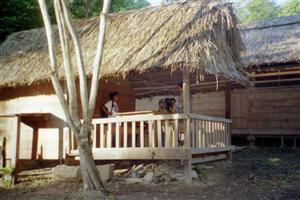|
The
culture of the Rupununi is fun and relaxed most of the time, or crazy
and celebratory at times. Food comes from hard work to harvest cassava
(manioc) as depicted here. Meat comes from fish, wild meat or the
shop(beef or chicken).
|
|
|
Cassava Farm
Cassava is planted in
farms at the foot of the mountains or near the village. |
Planting Cassava
Cassava,
the staple crop, is planted in raised beds by vegetative sticks that
grow into full plants. The root tubers grow into large starchy masses
in the ground, like yams, and are harvested.
|
|
Grating Cassava
After
the harvested tubers are scraped clean of the skin, the whole lot is
grated and collected. This is then processed in different ways,
depending on the final food product- farine, tapioca, cassava bread,
parakari (an alcoholic drink), or others.
|
|
|
|
Parching Farine
Farine is parched over
a fire on a large pan. The batch must be constantly stirred
to prevent scorching. |
Spinning Cotton
Local wild cotton is
harvested and spun and then woven into slings to carry babies or into
hammocks, as well as various other items.
|
|
|
|
Riding on Horseback
Horses are the constant
companion of the vaqueros, ranch hands of the Rupununi.
|
Parishara Dance
Special
occasions in villages sometimes see people dancing parishara, or tukui,
traditional dances of the Makusi. Most parties will see people dancing
to the Brazilian forro music.
|
|
|

|
Trail Guesthouses
Many
villages have nature trails, and offer all the sights you might expect
from a hike in the forest, from brilliantly colored birds to astounding
plants and amazing animals. Shown here are the trailside accomodations
in Aranaputa. |
|
River Landing
Here is Kenny at
Yakarinta landing with horse, boat, bicycle and his own feet, all you
need to travel in the Rupununi.
|
|



